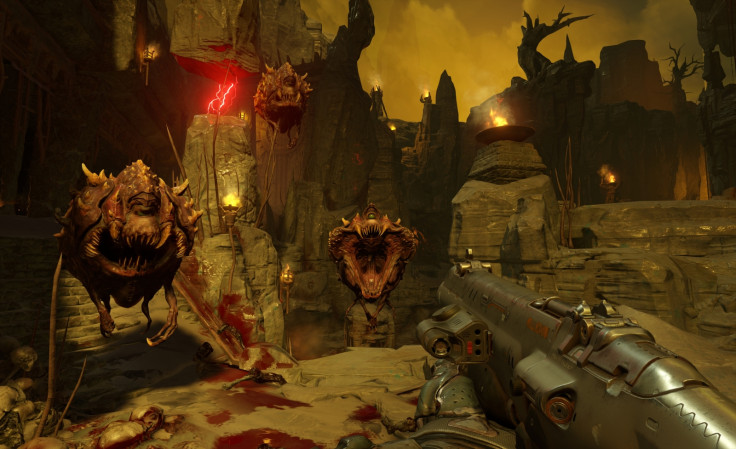E3 2015: Forget Doom, we just got Quake 3 multiplayer for PS4 and Xbox One

Last night, hidden between the oversized weaponry and incessant showers of blood and guts, id Software's Marty Stratton announced something I never expected to be at E3 this year, a spiritual successor to the mighty Quake.
While the single player gameplay displayed during the keynote offered up a tantalisingly classic-looking Doom experience - focused on hectic gunplay, speedy movement and skull-splitting violence – I felt that the real star of the show was the newly-announced multiplayer mode and how this brings something very important and long overdue to the table.
The arena shooter is a staple in the FPS genre; it provides unrelenting and competitive combat that can't usually be found in the regular shooters, lending itself beautifully to multiplayer action. Where Doom cemented the genre-defining first-person viewpoint, Quake grounded arena shooters in the history books with its aptly-titled third instalment Quake 3: Arena.
Together these two games are arguably responsible for many titles you'll be familiar with today. The likes of Titanfall and Call of Duty: Advanced Warfare have each benefited from the ideas of vertical gameplay, team-based modes and super-human speed that all stem from both early Doom and Quake games.
It's the speed at which these games operate that really popularised them, forcing players to sharpen their competitive edge as the difference between victory and just being another frag has dwindled to mere milliseconds.
This rebooted Doom exhibited during Bethesda's first E3 press conference is continuing this fast-paced and action-filled gameplay, moving it away from the horror-esque experiences found in the corridors of Doom 3 and boldly placing it back into the territory of its classic forefathers.
Outshining old tropes
The keynote brought about impressive gameplay that was stuffed to the seams with fan appeal, but I couldn't help feeling like it all looked rather safe. From what we saw and heard, little new ground appears to have been covered in the solo mode – not necessarily a bad thing considering the pedigree, but it certainly made the multiplayer announcement stand out.

The eccentricities of the Doom franchise are perfectly sculpted for a multiplayer experience and the reboot takes the gory carnage and spreads it about a handful of tight UAC facility arenas like a cannibal's finger painting with confirmed modes like Deathmatch and Domination cropping up in the demonstration.
I see this new addition having the potential to outshine the old tropes of the comfortable campaign with the kind of jaw-clenching mayhem that made Quake 3 so popular - and that's no bad thing. FPS titles like Call of Duty have proved enduringly popular chiefly through the high replay value of multiplayer modes, not always the single player.
Bringing this new angle to Doom smartly shifts it into a whole new market, rubbing shoulders with some of the most adored shooters on the market, such as Team Fortress 2, while keeping a severed limb firmly grounded in its franchise roots.
SnapMap
If its comparisons with the arena shooters of old weren't reason enough to be excited, id has thrown in its own take on Halo's Forge mode for good measure with SnapMap. I adored the freedom offered with Forge mode and the systems that influenced it like TimeSplitter's level editor and the huge modding scene for Quake.
Map-making enables you to implement the changes you want to see and produce something unique; it's often a rewarding and challenging peripheral to any game. Modding is hugely important to PC gaming and has been integral to the longevity of arena shooters over the years. Bringing these kind of tools to the console platforms too is an intelligent move.
The existing, dedicated player-base are sure to spawn numerous, inventive game modes way out of the boundaries of the developers and their own ideas, breathing new life into Doom's multiplayer experience and casting a darker shadow over the single player mode with every upload.
Adding a multiplayer mode to Doom was largely expected, especially in this era of online-focused gaming, but its not a series I ever expected to mimic the Quake formula so closely.
id Software are set to make a serious and bloody splash here, honourably preserving their ground-breaking and influential staple while propelling it into the modern era of gaming with bone-crunching finesse.
Smoothly tacking on a functional and manic arena shooter experience is the icing on the proverbial cake, bringing something that's been on my wish list for as long as I can remember to fruition: Quake's long-awaited spiritual successor.
Ben Tarrant is a freelance writer who has worked for Official PlayStation Magazine and Push Square. You can follow him on Twitter @Ben_Tarrant.
For all the latest video game news follow us on Twitter @IBTGamesUK.
© Copyright IBTimes 2025. All rights reserved.



















